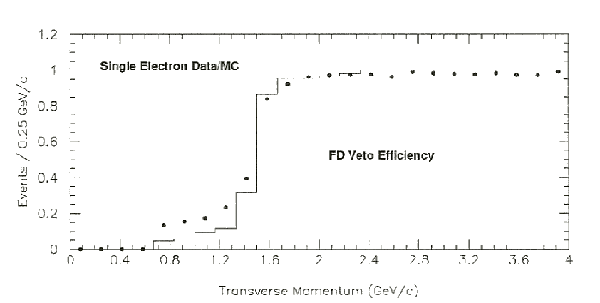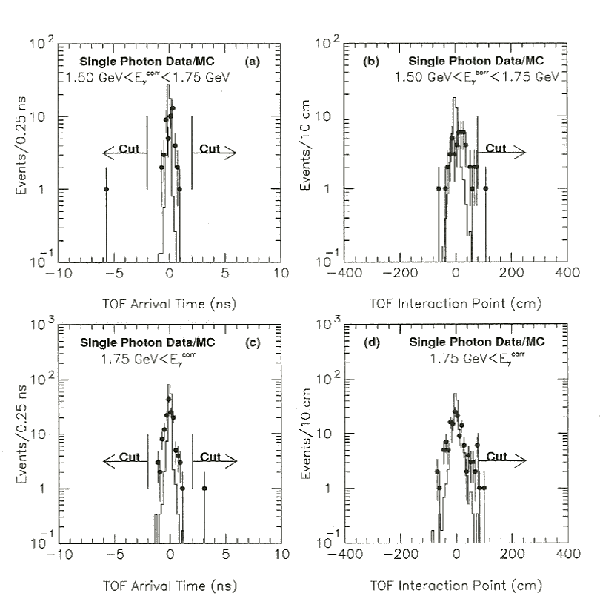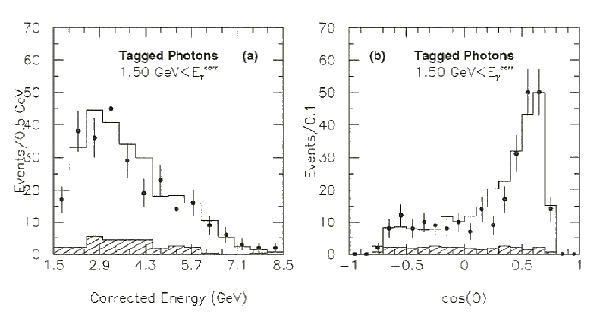


Chapter 9
Single Photon Backgrounds
Any process other than the signal, e+e-® n[`(n)]g, which produces the same type of
signal in the detector is background to the desired signal process and must
be accurately accounted for before a measurement of the number of light
neutrinos can be made.
For this reason, all potential physics and non-physics processes which might
contribute in first order are considered in detail.
Among these backgrounds are the physics processes e+e-® e+e-g, e+e-® gg, e+e-® e+e-X (X® f2,p0,h,h¢), e+e-® m+m-g,
e+e-® t+t-g, and e+e-® e+e-l+l-g.
In addition, other ``non-physics'' processes such as cosmic rays and beam
related processes are also considered.
Each process has been studied in detail using either direct Monte Carlo
simulation, i.e. for the explicit ``physics'' backgrounds, or special studies
using the data and Monte Carlo.
This chapter discusses the backgrounds to the single photon signal from the
process e+e-® n[`(n)]g including two of the more salient backgrounds, radiative Bhabha
scattering and the cosmic/beam related backgrounds.
9.1 Simulation of Single Photon Backgrounds
Although the backgrounds from the e+e-® e+e-l+l-g process have only been studied
analytically [24], all other physics backgrounds to the single
photon signal have been studied using Monte Carlo generated events with full
simulation of the OPAL detector or special studies of the data and the
selection criteria.
The Monte Carlo generators used for the various physics processes have already
been discussed in Subsection 5.3.
The Monte Carlo generators used include: TEEGG [68] for the
e+e-® e+e-g process, RADCOR [72] for the e+e-® gg(g) process,
TWOGEN [73] for the X® f2,p0,h,h¢ process, and KORALZ [78]
for the e+e-® m+m-g and e+e-® t+t-g processes.
A summary of the production for the single electron studies is shown in
Table 9.1 with the specific selection requirements of the Monte
Carlo four vectors.
The luminosity of the generated event samples amounts to more than five times
that of the data in all cases.
| SINGLE PHOTON MONTE CARLO PRODUCTION |
|
Acceptance - One photon with Eg > 0.8 GeV and qg > 300 mrad. |
| RUN | PROCESS | GENER. | ECM | EVTS.
| L (pb-1) |
| 1400 | e+e- ® n[`(n)]g | NNG03 | 93.70
| 1500 | 6.89±0.04 |
| 1401 | e+e- ® n[`(n)]g | NNG03 | 92.95
| 1250 | 5.30±0.03 |
| 1402 | e+e- ® n[`(n)]g | NNG03 | 91.95
| 1100 | 5.13±0.02 |
| 1403 | e+e- ® n[`(n)]g | NNG03 | 91.20
| 7000 | 50.0±0.11 |
| 1404 | e+e- ® n[`(n)]g | NNG03 | 90.20
| 350 | 5.25±0.05 |
| 1405 | e+e- ® n[`(n)]g | NNG03 | 89.45
| 200 | 4.73±0.07 |
| 1406 | e+e- ® n[`(n)]g | NNG03 | 88.45
| 150 | 6.05±0.10 |
|
Acceptance - One photon with Eg > 0.5 GeV
and qg > 300 mrad, |
|
and the other e± with q < 250 mrad. |
| RUN | PROCESS | GENER. | ECM | EVTS.
| L (pb-1) |
| 1302 | e+e- ® e+e-g | TEEGG | 91.25
| 4572 | 622.6±3.5 |
|
Acceptance - One photon with Eg > 0.5 GeV and
|cos(qg)| < 0.955. |
| RUN | PROCESS | GENER. | ECM | EVTS.
| L (pb-1) |
| 1700 | e+e- ® gg(g) | RADCOR
| 91.25 | 4109 | 126.10±1.97 |
| 1701 | e+e- ® ggg | RADCOR
| 91.25 | 2320 | 73.04±1.52 |
|
Acceptance - One photon with Eg > 0.5 GeV and
|cos(qg)| < 0.75. |
| RUN | PROCESS | GENER. | ECM | EVTS.
| L (pb-1) |
| 1706 | e+e- ® e+e-f2 | TWOGEN
| 91.25 | 50000 | 62.76±0.28 |
| 1707 | e+e- ® e+e-p0 | TWOGEN
| 91.25 | 200000 | 61.00±0.14 |
| 1708 | e+e- ® e+e-h | TWOGEN
| 91.25 | 42000 | 60.34±0.29 |
| 1709 | e+e- ® e+e-h¢ | TWOGEN
| 91.25 | 4000
| 62.91±0.99 |
Table 9.1: Monte Carlo Production for the Single Photon Analysis.
9.2 The Bhabha Background
The dominant background to the single photon signal, e+e-® n[`(n)]g, is by far the low
Q2 radiative Bhabha scattering where the electron and positron escape down
the beam pipe and the radiated photon is seen in the fiducial volume of the
detector.
For the purposes of vetoing these events, the forward detector is the most
important component of the OPAL detector.
Selection Criterion 6 removes events with more than 2 GeV of activity in either
forward calorimeter as discussed in Section 6.1.6.
This cut removes much of the background to the e+e-® n[`(n)]g signal at low angles,
especially the low Q2 Bhabha events.
Figure 9.1 shows the efficiency of the forward detector to tag
and veto single electrons events.
Although the tagging efficiency does not agree with the Monte Carlo for
1.00 GeV/c £ pt £ 1.30 GeV/c, for pt ³ 1.30 GeV the
tagging efficiency of the data and Monte Carlo agrees well and is more than
90%.
Since the threshold behavior of the Egcorr ³ 1.50 GeV cut for single photons
corresponds to the cut of pt ³ 1.30 GeV/c for single electrons, the
potentially large Bhabha background is well vetoed by the forward detector.
Figure 9.1: Tagging Efficiency of the Forward Detector.
The efficiency of the forward detector to veto events with activity of
2.0 GeV or more in either forward detector is shown as a function of the
transverse momentum for the single electrons.
The data points are shown by solid dots and the Monte Carlo is shown by the
solid histograms.
9.3 The Cosmic and Beam Related Background
Other potentially large backgrounds, more difficult to model, are the
backgrounds due to cosmic and beam related events.
The contribution from each of these two types of backgrounds can be estimated
from the accurate time measurement of the TOF system.
The true single photon signal is expected to emanate from near the origin of
the OPAL detector and activate a TOF scintillator within 7.9 ns.
Due to the random nature in time of the cosmic ray, scintillation of the TOF
by cosmics can occur at any time within the DAQ gating time of the TOF counter.
The same random nature of the beam related events also leads to events with
a z-interaction point along the beam axis which is not consistent with the
origin.
The z-interaction point along
the beam axis is determined from the accurate scintillation time of the TOF
according to
where the photon (b = 1.0) is at an angle, q, with the beam axis,
R is the radial distance, and ± is chosen to be - since the photon
is assumed to originate upstream.
Figure 9.2 shows the comparison of the arrival time, t0 , and
the interaction z-coordinate, zint , for the single photon candidates from the
1991 data and Monte Carlo for both the first sample with
1.5 GeV < Egcorr < 1.75 GeV and the second sample with Egcorr ³ 1.75 GeV.
From the t0 of the TOF system, both the first and the second sample
have been attributed 1.00±1.02 events due to the cosmic background from
events with | t0 | > 0.2 ns.
From the zint of the TOF system for those events which are not cosmic
background, the first sample is assigned a beam related background
of 2.00±1.43 events, while the second sample is attributed
1.00±1.02 background events from events with
| zint | > + 80.0 cm.
Figure 9.2: Backgrounds from Cosmic and Beam Sources.
The measured minus expected flight times, t0, for single
photon candidates shown by dots with statistical errors for the data and
by solid histograms for the Monte Carlo in (a) for the first sample and
in (c) the second sample.
The cuts for the cosmic rays are indicated by the arrows at |t0| < 0.2 ns.
After throwing out the suspected cosmic events from (a) and (c), the estimated
z coordinate, zint, of the single photon candidates for the
data are shown by solid dots with statistical errors and for the Monte Carlo
by the histogram in (b) for the first sample and in (d) the second sample.
The cuts for the beam related backgrounds are indicated by the arrows at
zint < 80 cm.
9.4 Total Backgrounds
Summaries of the total backgrounds as a function of the center-of-mass energy
point is shown in Table 9.2 and as a function of the originating
physics process in Table 9.3.
For the first sample (photon energies in the range
1.5 GeV < Egcorr < 1.75 GeV), the total number of background events is
18.39±3.43, corresponding to over 40% of the single photon signal.
However, for the second sample (photon energies Egcorr ³ 1.75 GeV),
the total number of background events is 12.31±2.24, only about 8% of the
single photon signal.
| Ös | BACKGROUND CONTRIBUTION |
| (GeV)
| 1.5 GeV < Egcorr < 1.75 GeV
| Egcorr > 1.75 GeV | |
| | 88.45 | 1.17±0.45±0.28 | 0.66±0.36±0.16 |
| 89.45 | 1.09±0.44±0.26 | 0.62±0.36±0.14 |
| 90.20 | 1.21±0.46±0.29 | 0.79±0.37±0.16 |
| 91.20 | 11.38±1.72±2.67 | 7.88±1.35±1.50 |
| 91.95 | 1.11±0.44±0.26 | 0.72±0.36±0.14 |
| 92.95 | 1.19±0.45±0.28 | 0.81±0.37±0.15 |
| 93.70 | 1.23±0.47±0.29 | 0.83±0.38±0.16 | |
| | TOTAL | 18.39±2.04±2.76 | 12.31±1.62±1.55 |
|
Table 9.2: Total Backgrounds vs. Center-of-Mass Energy Points.
The total backgrounds for the single photon signal, e+e-® n[`(n)]g, are shown
versus the center-of-mass energy.
The first column gives the background for the first sample with
1.5 GeV < Egcorr < 1.75 GeV and the second column gives the background
for the second sample with Eg ³ 1.75 GeV.
The errors are the statistical and the assigned systematic error.
| PHYSICS | BACKGROUND CONTRIBUTION |
| SOURCE
| 1.5 GeV < Egcorr < 1.75 GeV
| Egcorr > 1.75 GeV | |
| | 1) e+e-® e+e-g
| 11.35±0.87±2.67 | 6.08±0.64±1.47 |
| 2) e+e-® gg(g)
| 0.32±0.08±0.03 | 2.11±0.20±0.31 |
| 3) e+e-® e+e-X
| 2.07±0.55±0.43 | 0.69±0.32±0.16 |
| X® f2,p0,h,h¢ | | |
| 4) e+e-® m+m-g
| 1.58±0.34±0.41 | 1.05±0.28±0.25 |
| 5) e+e-® t+t-g
| 0.06±0.01±0.00 | 0.37±0.04±0.00 |
| 6) e+e-® e+e-l+l-g
| 0.01±0.00±0.01 | 0.01±0.00±0.00 |
| 7) Cosmics | 1.00±1.00±0.13 | 1.00±1.00±0.13 |
| 8) Beam | 2.00±1.41±0.32 | 1.00±1.00±0.16 | |
| | TOTAL | 18.39±2.04±2.76 | 12.31±1.62±1.55 |
|
Table 9.3: Total Backgrounds vs. Source.
The total backgrounds for the single photon signal are shown separately
for the background process.
The first column gives the background for the first sample with
1.00 GeV £ Egcorr £ 1.75 GeV and the second column gives the background
for the second sample with Eg ³ 1.75 GeV.
As an overall check of the efficiencies and backgrounds, a study has been
performed to compare the tagged single photon events with the expectations
from the processes e+e- ® e+e-g and e+e-® gg(g).
As discussed previously, the tagged single photon events are those in which
a single photon is seen in the fiducial volume of the detector with an electron
or positron depositing more than 2.0 GeV in the forward detector without
leaving a track in the central detector while the other positron or electron
escapes detection down the beam pipe.
Figure 9.3 shows the agreement between the 1991 data, the
Monte Carlo simulation for e+e- ® e+e-g and e+e-® gg(g)for
the tagged single photon events.
After correcting for an overall trigger efficiency of 97.93±0.21%
and for the total veto efficiencies described above, the ratio of the observed
cross-section to that expected from the lowest order Monte Carlo calculations
is 1.06±0.06±0.04.
Figure 9.3: Tagged Single Photon Events.
The single photon events, tagged by more than one half of the beam energy
deposited in a forward detector, are compared with the expectations form e+e-® e+e-g
shown by the unshaded areas and e+e-® gg(g) shown by the shaded histograms.
Shown in (a) is the energy spectrum of the single photons and in (b) the cosine
of the angle between the photon and the beam axis from the tagging side.






